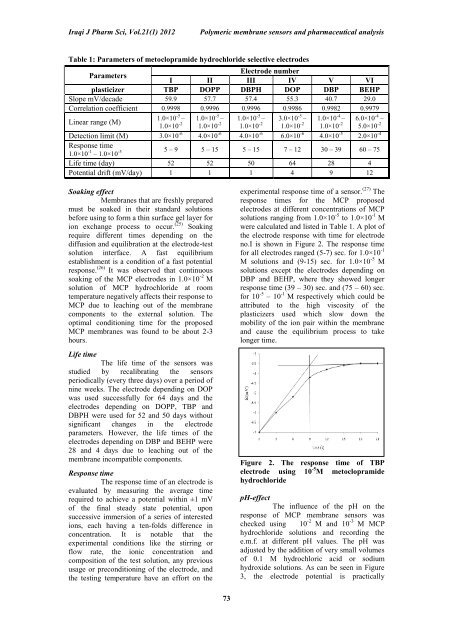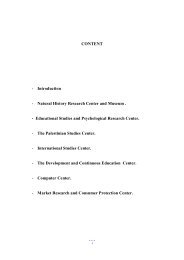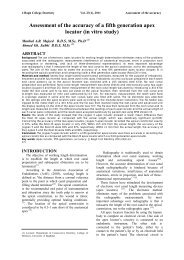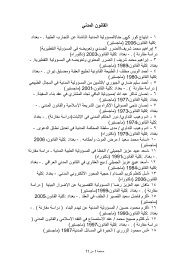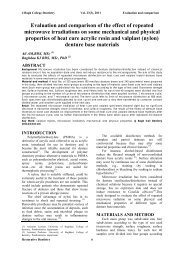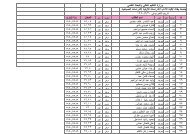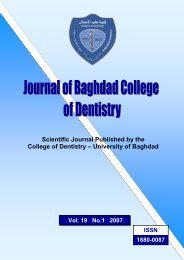Polymeric Membrane Sensors for The Selective Determination of ...
Polymeric Membrane Sensors for The Selective Determination of ...
Polymeric Membrane Sensors for The Selective Determination of ...
Create successful ePaper yourself
Turn your PDF publications into a flip-book with our unique Google optimized e-Paper software.
Iraqi J Pharm Sci, Vol.21(1) 2012<br />
<strong>Polymeric</strong> membrane sensors and pharmaceutical analysis<br />
Table 1: Parameters <strong>of</strong> metoclopramide hydrochloride selective electrodes<br />
Parameters<br />
Electrode number<br />
I II III IV V VI<br />
plasticizer TBP DOPP DBPH DOP DBP BEHP<br />
Slope mV/decade 59.9 57.7 57.4 55.3 40.7 29.0<br />
Correlation coefficient 0.9998 0.9996 0.9996 0.9986 0.9982 0.9979<br />
Linear range (M)<br />
1.0×10 -5 – 1.0×10 -5 – 1.0×10 -5 – 3.0×10 -5 – 1.0×10 -4 – 6.0×10 -4 –<br />
1.0×10 -2 1.0×10 -2 1.0×10 -2 1.0×10 -2 1.0×10 -2 5.0×10 -2<br />
Detection limit (M) 3.0×10 -6 4.0×10 -6 4.0×10 -6 6.0×10 -6 4.0×10 -5 2.0×10 -4<br />
Response time<br />
1.0×10 -1 – 1.0×10 -5<br />
5 – 9 5 – 15 5 – 15 7 – 12 30 – 39 60 – 75<br />
Life time (day) 52 52 50 64 28 4<br />
Potential drift (mV/day) 1 1 1 4 9 12<br />
Soaking effect<br />
<strong>Membrane</strong>s that are freshly prepared<br />
must be soaked in their standard solutions<br />
be<strong>for</strong>e using to <strong>for</strong>m a thin surface gel layer <strong>for</strong><br />
ion exchange process to occur. (25) Soaking<br />
require different times depending on the<br />
diffusion and equilibration at the electrode-test<br />
solution interface. A fast equilibrium<br />
establishment is a condition <strong>of</strong> a fast potential<br />
response. (26) It was observed that continuous<br />
soaking <strong>of</strong> the MCP electrodes in 1.0×10 -2 M<br />
solution <strong>of</strong> MCP hydrochloride at room<br />
temperature negatively affects their response to<br />
MCP due to leaching out <strong>of</strong> the membrane<br />
components to the external solution. <strong>The</strong><br />
optimal conditioning time <strong>for</strong> the proposed<br />
MCP membranes was found to be about 2-3<br />
hours.<br />
Life time<br />
<strong>The</strong> life time <strong>of</strong> the sensors was<br />
studied by recalibrating the sensors<br />
periodically (every three days) over a period <strong>of</strong><br />
nine weeks. <strong>The</strong> electrode depending on DOP<br />
was used successfully <strong>for</strong> 64 days and the<br />
electrodes depending on DOPP, TBP and<br />
DBPH were used <strong>for</strong> 52 and 50 days without<br />
significant changes in the electrode<br />
parameters. However, the life times <strong>of</strong> the<br />
electrodes depending on DBP and BEHP were<br />
28 and 4 days due to leaching out <strong>of</strong> the<br />
membrane incompatible components.<br />
Response time<br />
<strong>The</strong> response time <strong>of</strong> an electrode is<br />
evaluated by measuring the average time<br />
required to achieve a potential within ±1 mV<br />
<strong>of</strong> the final steady state potential, upon<br />
successive immersion <strong>of</strong> a series <strong>of</strong> interested<br />
ions, each having a ten-folds difference in<br />
concentration. It is notable that the<br />
experimental conditions like the stirring or<br />
flow rate, the ionic concentration and<br />
composition <strong>of</strong> the test solution, any previous<br />
usage or preconditioning <strong>of</strong> the electrode, and<br />
the testing temperature have an ef<strong>for</strong>t on the<br />
experimental response time <strong>of</strong> a sensor. (27) <strong>The</strong><br />
response times <strong>for</strong> the MCP proposed<br />
electrodes at different concentrations <strong>of</strong> MCP<br />
solutions ranging from 1.0×10 -5 to 1.0×10 -1 M<br />
were calculated and listed in Table 1. A plot <strong>of</strong><br />
the electrode response with time <strong>for</strong> electrode<br />
no.I is shown in Figure 2. <strong>The</strong> response time<br />
<strong>for</strong> all electrodes ranged (5-7) sec. <strong>for</strong> 1.0×10 -1<br />
M solutions and (9-15) sec. <strong>for</strong> 1.0×10 -5 M<br />
solutions except the electrodes depending on<br />
DBP and BEHP, where they showed longer<br />
response time (39 – 30) sec. and (75 – 60) sec.<br />
<strong>for</strong> 10 -5 – 10 -1 M respectively which could be<br />
attributed to the high viscosity <strong>of</strong> the<br />
plasticizers used which slow down the<br />
mobility <strong>of</strong> the ion pair within the membrane<br />
and cause the equilibrium process to take<br />
longer time.<br />
Figure 2. <strong>The</strong> response time <strong>of</strong> TBP<br />
electrode using 10 -5 M metoclopramide<br />
hydrochloride<br />
pH-effect<br />
<strong>The</strong> influence <strong>of</strong> the pH on the<br />
response <strong>of</strong> MCP membrane sensors was<br />
checked using 10 -2 M and 10 -3 M MCP<br />
hydrochloride solutions and recording the<br />
e.m.f. at different pH values. <strong>The</strong> pH was<br />
adjusted by the addition <strong>of</strong> very small volumes<br />
<strong>of</strong> 0.1 M hydrochloric acid or sodium<br />
hydroxide solutions. As can be seen in Figure<br />
3, the electrode potential is practically<br />
73


